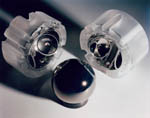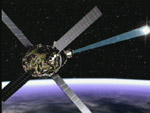WEEKLY HIGHLIGHTS FOR 21 MAY 2004:
GRAVITY PROBE B MISSION UPDATE

One month into the mission, all spacecraft subsystems are continuing to perform well. The spacecraft’s orbit remains stable and meets our requirements for next month’s transition into the science phase of the mission, upon completion of the spacecraft initialization and orbit checkout. The four gyroscopes are suspended, and we have indications that they are rotating slightly in their housings.
- Last weekend, the team successfully performed a procedure to reduce magnetic
flux that had built up around the gyroscope rotors (spheres). Magnetic flux
is a measure of the number of magnetic field lines penetrating a surface. To
ensure that the SQUID readouts receive clean signals from the gyroscopes and
to provide the highest possible degree of accuracy during the GP-B science
experiment, any magnetic flux around the gyroscope rotors must be minimized.
- We reduce magnetic flux by turning on heaters and flowing helium gas, warmed
to 10 Kelvin, through the probe. This process also drives off any residual
helium remaining in the well of the Dewar, where the probe sits. The flux
reduction procedure went smoothly, and when it was completed, the level of
trapped flux
remaining within the gyros was almost imperceptible. In fact, gyroscope #4,
which previously had the highest amount of trapped magnetic flux of all the
gyros now has the lowest level.
- The flux reduction procedure added heat to the Dewar, thereby increasing
the pressure inside to its maximum allowable level. The increased pressure
during
this stress period caused some of the spacecraft’s micro thrusters to
become unstable, resulting in the spacecraft pointing in the wrong direction
and triggering a “safemode.”

- The 16 micro thrusters are arranged in clusters of four, and local feedback
loops within each cluster enable the thrusters to communicate with each
other and automatically adjust their flow rates. Ground commands were issued
to
isolate the unstable thrusters, which resolved the thruster cross-talk issue
and enabled
the spacecraft to re-orient itself. The thrusters are now functioning properly,
the spacecraft’s attitude has been corrected, and it is once again
pointing towards the guide star.
- The flux reduction operation and subsequent thruster instability and attitude problems has delayed locking the spacecraft onto the guide star, which will be our next major activity. While we have used up some of the contingency days built into the Initialization & Orbit Checkout (IOC) schedule, this phase of the Gravity Probe B mission is still on track for completion within 60 days after launch, at which time the 13-month science data collection will begin. This will be followed by a two-month final calibration of the science instrument assembly.


The spacecraft is being controlled from the Gravity Probe B Mission Operations Center, located here at Stanford University. The Stanford-NASA/MSFC-Lockheed Martin operations team is continuing to perform superbly.
Please Note: During the Initialization & Oribit Checkout (IOC) Phase of the GP-B mission, we will update this Web site and send out an email update once a week (usually on Thursday or Friday) to keep you appraised of our progress. From time to time, we may post and email extra updates, as warranted by mission events.
Photos and drawing: The first photo, showing the Delta II rocket and payload lifting off of the launch pad is courtesy of the Boeing Corporation. The photo of they GP-B gyroscope rotor (sphere) and housings was taken by photographer Don Harlan. The photo of two micro thrusters is courtesy of Lockheed Martin Corporation. The drawing of the GP-B spacecraft on orbit, was extracted from an animation created by Adam Jeziak and Aaron Pozzer at York University in Toronto, Canada. Click on the thumbnails to view enlarged copies of these images.
TRACKING THE GP-B SPACECRAFT
Find the Gravity Probe B satellite in the sky at NASA's satellite tracking web site. See where GP-B is with respect to the terminator (the day-night boundary on the Earth's surface), or just enter your zip code to see if GP-B might be over your neighborhood. The best time to look for it is usually at dusk.
Also, you can track the GP-B spacecraft on your Palm OS or Pocket PC Personal Digital Assistant (PDA), using either PocketSat or PocketSat+ from Big Fat Tail Productions. Both products are PDA Shareware, so you can try them out for free. If you decide to use them, Big Fat Tail asks that you pay a nominal shareware fee.
LEARN MORE ABOUT THE GP-B GUIDE STAR, IM PEGASI
For an overview about why we chose IM Pegasi as our guide star, and its importance to the GP-B mission, see our Guide Star FAQ.
Also, the ETH Institute of Astronomy in Zurich, Switzerland, is working with the Harvard-Smithsonian Center for Astrophysics to provide detailed optical information about the GP-B guide star, IM Pegasi. You can find out about the ETH Institute's work in monitoring magnetic activity on IM Pegasi and the Doppler Imaging Technique used for this purpose on the ETH Institute of Astronomy GP-B Web page.
FOLLOW IOC ACTIVITIES AND LEARN MORE ABOUT GRAVITY PROBE B
If you are interested in following the IOC procedures more closely, you'll find a schedule and description of them on pages 12-14 of the Gravity Probe B Launch Companion. This document also provides an overview and explanation of the Gravity Probe B experiment and information about the spacecraft and GP-B's amazing technologies. Click here to download the GP-B Launch Companion in Adobe Acrobat PDF format. (Please note: this file is 1.6 MB, so it may take awhile to download if you have a slow Internet connection.)
VIEW A VIDEO OF THE GP-B LAUNCH
 Click
here to view a 3 1/2 minute QuickTime video clip of the GP-B launch, produced
by the Stanford News Service. Please note that the video requires Quick Time to play.
Click here to
link to
download Quick Time.
Click
here to view a 3 1/2 minute QuickTime video clip of the GP-B launch, produced
by the Stanford News Service. Please note that the video requires Quick Time to play.
Click here to
link to
download Quick Time.![]()
FOLLOWING THE GP-B MISSION ON THE WEB
In addition to this Web site, here are some other Web sites that have information, photos, and video of the GP-B launch and mission.
- The ELV Missions Virtual Launch Center Web page on the John F. Kennedy Space Center Web site has information and several streaming video clips covering the GP-B mission. (You can view these video clips free of charge, but you will need to have either the Real Media Player or Windows Media Player installed on your computer to view them.)
- NASA's Marshall Space Flight Center Gravity Probe B.com Web page has a number of great photos from the GP-B launch, including photos of the spacecraft separation, as well as other information about Gravity Probe B.
- The Science @ NASA Web site, hosted by NASA's Marshall Space Flight Center, posts several stories each month about scientific research projects in which NASA is involved. This site currently features two general interest stories about Gravity Probe B: In search of Gravitomagnetism and A Pocket of Near Perfection. (In addition to the Web versions, these stories are also available in both plain text and streaming audio formats.)
- Photographer William G. Hartenstein's Web site has an extraordinary set of photos that he took on launch day.
- Another very comprehensive source of information about the GP-B launch is the Spaceflight Now Web site. This site contains an excellent photo gallery, as well as a number of Quicktime video clips of the launch. However, you have to become a subscriber to this site ($$$) in order to view the video clips.
GRAVITY PROBE B IN THE NEWS
Sunday evening, April 18th, a feature story about Gravity Probe B and principal investigator, Francis Everitt, aired on ABC World News Tonight. Click here to read a text version of the ABC News story. Also on April 18th, NPR's David Kestenbaum talked with GP-B's principal investigator, Francis Everitt on the program All Things Considered. On Friday, April 16th, Gravity Probe B Co-Principal Investigator, John Turneaure, was interviewed by Ira Flatow on NPR Talk of the Nation—Science Friday.
On Tuesday, April 13,2004, Gravity Probe B was the lead story in the Science section of the New York Times, and it was one of the front page stories in the San Jose Mercury News. (You'll need to register on the Web sites of these newspapers to view these stories online.) In addition, a story about GP-B appeared on the New Scientist Web on April 13, 2004.
The official pre-launch Gravity Probe B mission and science briefing was held on Friday, April 2, 2004 at 1:00 PM Eastern Daylight Time at NASA Headquarters in Washington, D.C. The participants in the briefing (pictured from left to right in the photo) were:

- Anne Kinney, Director of Astronomy/Physics Division, NASA Headquarters
- Rex Geveden, Program Manager, GP-B and Deputy Director, NASA's Marshall Space Flight Center in Huntsville, Alabama.
- Francis Everitt, GP-B Principal Investigator at Stanford University, Stanford, California
- Bradford Parkinson, GP-B Co-Principal Investigator at Stanford University, Stanford California
- Kip Thorne, Feynman Professor of Theoretical Physics, California Institute of Technology, Pasadena, California
You can view a Real Player streaming video of this briefing on the Kennedy Space Center GP-B Web site.
RECEIVE GRAVITY PROBE B WEEKLY HIGHLIGHTS BY EMAIL
If you are interested in automatically receiving these weekly highlights and other important GP-B mission information by email, you can subscribe to our Gravity Probe B Update email list by sending an email message to "majordomo@lists.Stanford.edu" with the command "subscribe gpb-update" in the body of the message (not in the Subject line). You can unsubscribe from this mailing list at any time by sending an email message to the same address with the command, "unsubscribe gpb-update" in the body of the message.
Previous Highlight
Index of Highlights
